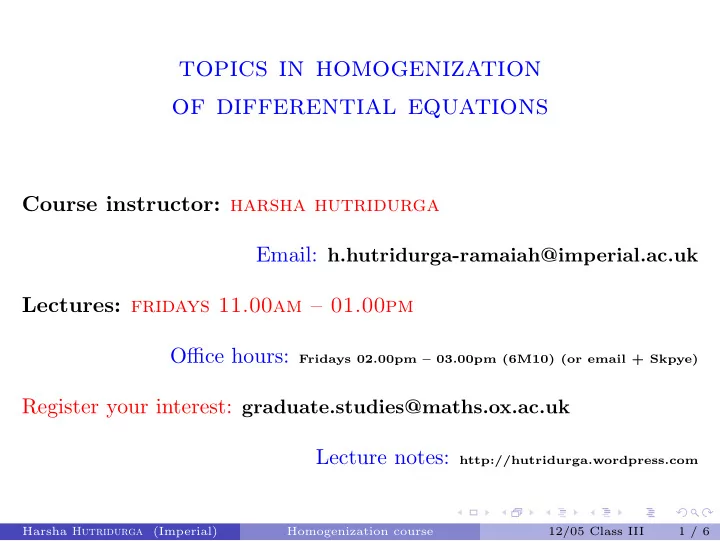

topics in homogenization of differential equations Course instructor: harsha hutridurga Email: h.hutridurga-ramaiah@imperial.ac.uk Lectures: fridays 11.00am – 01.00pm Office hours: Fridays 02.00pm – 03.00pm (6M10) (or email + Skpye) Register your interest: graduate.studies@maths.ox.ac.uk Lecture notes: http://hutridurga.wordpress.com Harsha Hutridurga (Imperial) Homogenization course 12/05 Class III 1 / 6
references of interest [BLP78] bensoussan, lions, papanicolaou Asymptotic methods in periodic structures , Stud. Math. Appl., 5, (1978). [S-P80] sanchez-palencia Non homogeneous media and vibration theory , Lect. Notes Phy., 127, (1980). [JKO94] jikov, kozlov, oleinik Homogenization of Differential Equations and Integral Functionals , (1994). [CD99] cioranescu, donato An introduction to Homogenization , (1999). [All02] allaire Shape optimization by the homogenization method , Appl. Math. Sci., 146, (2002). [PS08] pavliotis, stuart Multiscale methods: averaging and homogenization , (2008). [Tar09] tartar The general theory of homogenization – A personalized introduction , (2009). Harsha Hutridurga (Imperial) Homogenization course 12/05 Class III 2 / 6
quick recap from last session Treated the one dimensional problem a ε ( x )du ε − d � � = f ( x ) in ( ℓ 1 , ℓ 2 ) , d x d x u ε ( ℓ 1 ) = u ε ( ℓ 2 ) = 0 . Assumption on the conductivity sequence: Entire sequence a ε − ⇀ a ∗ weakly ∗ in L ∞ − − − which implies that the entire sequence 1 weakly ∗ in L ∞ a ε − − − − ⇀ a ∗ Harsha Hutridurga (Imperial) Homogenization course 12/05 Class III 3 / 6
one dimensional homogenization result Entire sequence u ε is such that u ε − weakly in H 1 ⇀ u 0 0 (Ω) − − − Accumulation point u 0 solves − d � 1 du 0 � = f ( x ) in ( ℓ 1 , ℓ 2 ) , d x a ∗ ( x ) d x u 0 ( ℓ 1 ) = u 0 ( ℓ 2 ) = 0 . In periodic setting, we have 1 1 � weakly ∗ in L ∞ ⇀ a ( y ) d y a ε − − − − Y which implies that the homogenized conductivity � − 1 1 �� d y = a ( y ) a ∗ Y Harsha Hutridurga (Imperial) Homogenization course 12/05 Class III 4 / 6
method of oscillatory test functions Elliptic boundary value problem for the unknown u ε ( x ) � x � � ∇ u ε � − div A = f in Ω , ε u ε = 0 on ∂ Ω . Weak formulation � � x � � ∇ u ε ( x ) · ∇ ϕ ( x ) d x = A f ( x ) ϕ ( x ) d x ε Ω Ω Idea of Tartar : Replace ϕ ( x ) by a sequence ϕ ε ( x ) By the method of two-scale asymptotic expansions � ∂u 0 d � x u ε ( x ) = u 0 ( x ) + ε � ( x ) ω i ε ∂x i i =1 ω 1 ( y ) , . . . , ω d ( y ) are solutions to cell problems Harsha Hutridurga (Imperial) Homogenization course 12/05 Class III 5 / 6
cell problems and their duals Cell problems: � � �� − div y A ( y ) ∇ y ω i ( y ) + e i = 0 for y ∈ Y, y �→ ω i ( y ) is Y -periodic. Dual cell problems: � � �� A ⊤ ( y ) ∇ y ω ∗ − div y i ( y ) + e i = 0 for y ∈ Y, y �→ ω ∗ i ( y ) is Y -periodic. Sequence of test functions: � ∂ϕ d � x � ϕ ε ( x ) = ϕ ( x ) + ε ω ∗ ( x ) i ε ∂x i i =1 Harsha Hutridurga (Imperial) Homogenization course 12/05 Class III 6 / 6
Recommend
More recommend